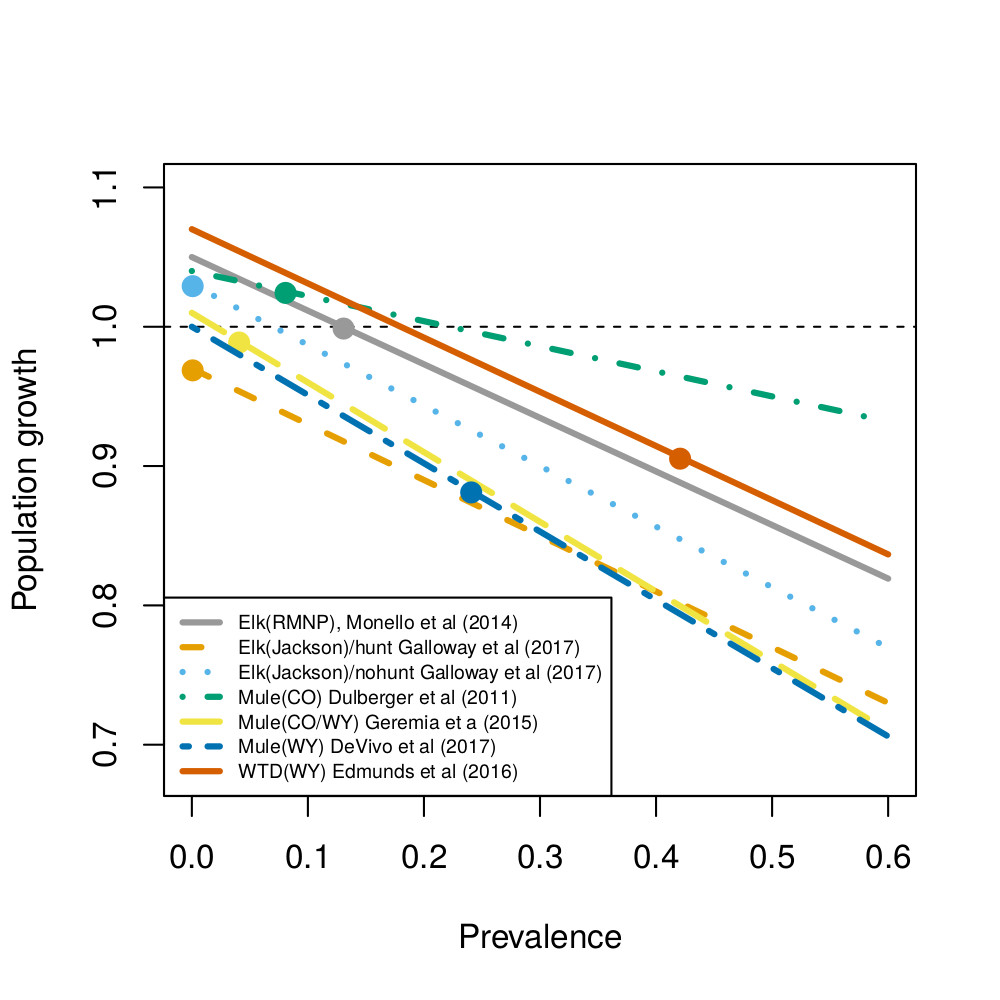Population Impacts

The population impacts of CWD, driven by increased prevalence, disease-associated mortality, and reduced recruitment for female cervids, also depend on species demographic patterns, harvest levels, other sources of mortality, and other factors [4]. The emergence of CWD has coincided with large declines of several highly infected populations of elk, mule deer, and white-tailed deer in Colorado and Wyoming [1,2,6,3,7]. These endemic areas have had CWD cases in wild cervid herds since the early 1980s and prevalence has increased to levels that are likely causing population declines [6]. However, a potentially confounding factor has been management policies that reduced abundance in some areas over this same period [3].
Population models of different cervids indicate that once female CWD prevalence reaches a species-specific threshold, the combined effects on survival and recruitment lead to population declines (See figure above). This threshold depends on species demographics, hunter harvest, and other mortality pressures. In contrast, observable population effects are unlikely early in the disease cycle, when prevalence is low and little mortality is attributed to the disease. Genetic selection also confounds long-term population predictions because increasing the number of lower susceptible animals will decrease disease-associated mortality, through lower infection rates and prolonged pre-clinical incubation [8]. Population monitoring effort should be increased in areas with high or increasing prevalence because population declines are likely. Additionally, population studies in the endemic areas of Colorado and Wyoming have not examined other limiting factors that could also contribute to population declines, including habitat loss, climate change, and population reductions, to mitigate the effects of over-browsing [3,5].
Literature Cited
1. DeVivo MT, Edmunds DR, Kauffman MJ, Schumaker BA, Binfet J, Kreeger TJ, et al. Endemic chronic wasting disease causes mule deer population decline in Wyoming. PLOS ONE. 2017 Oct 19;12(10):e0186512.
2. Edmunds DR, Kauffman MJ, Schumaker BA, Lindzey FG, Cook WE, Kreeger TJ, et al. Chronic wasting disease drives population decline of white-tailed deer. PLOS ONE. 2016 Aug;11(8):e0161127.
3. Geremia C, Miller MW, Hoeting JA, Antolin MF, Hobbs NT. Bayesian modeling of prion disease dynamics in mule deer using population monitoring and capture-recapture data. PLOS ONE. 2015;10(10):e0140687.
4. Hudson PJ, editor. Ecology of Wildlife Diseases. Oxford, UK ; New York: Oxford, UK ; New York : Oxford University Press; 2002.
5. Leiss W, Westphal M, Tyshenko MG, Croteau MC, Oraby T, Adamowicz W, et al. Challenges in managing the risks of chronic wasting disease. International Journal of Global Environmental Issues. 2017;16(4):277.
6. Miller MW, Swanson HM, Wolfe LL, Quartarone FG, Huwer SL, Southwick CH, et al. Lions and prions and deer demise. PLOS ONE. 2008;3(12):e4019.
7. Monello RJ, Powers JG, Hobbs NT, Spraker TR, Watry MK, Wild MA. Survival and population growth of a free-ranging elk population with a long history of exposure to chronic wasting disease. The Journal of Wildlife Management. 2014;78(2):214–223.
8. Williams AL, Kreeger TJ, Schumaker BA. Chronic wasting disease model of genetic selection favoring prolonged survival in Rocky Mountain elk (Cervus elaphus). Ecosphere. 2014 May;5(5):60.
